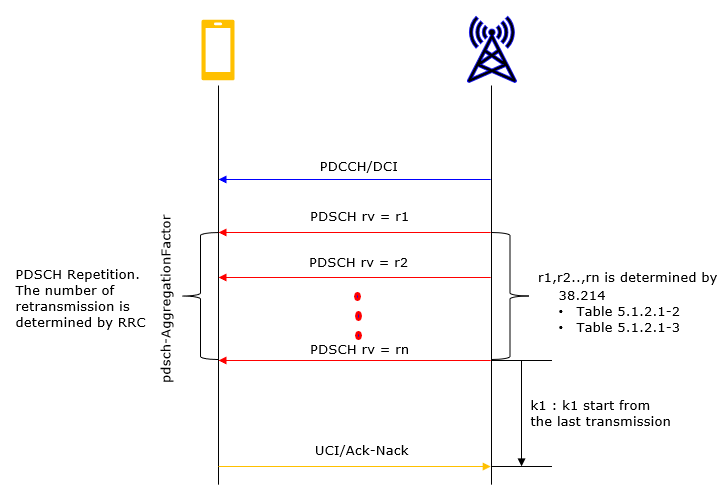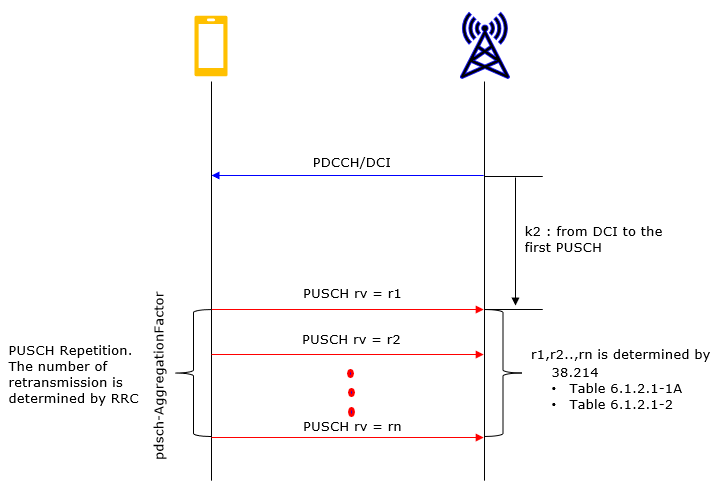|
|
||
|
The term Aggregation Factor in this context refers to the aggregation in time domain, more specifically the PDSCH and PUSCH over multiple consecutive slots. Those multiple PDSCH and PUSCH in this mechanism carries the same user data but with different redundancy version. It means those multiple PDSCH or PUSCH is basically the repetative transmission of a same data like the repetition mechanism you saw in TTI bundling and repetion in LTE and LTE CatM.
PDSCH Aggregation Factor/RepetitionSchemeConfigPDSCH Aggregation is a kind of PDSCH repetition mechanism for reliable transmission (of course at the sacrifice of throughput). Overall concept would be similar to TTI Bundling in LTE (in LTE TTI bundling is for Uplink. You may take PDSCH Aggregation is downlink version of TTI bundling) or it can be comparable to PDSCH repetition in Cat M or NBIot in LTE. Overall mechanism of PDSCH Aggregation can be illustrated as below.
In Release 15, 3GPP allows three types of repeition (n2, n4, n8) and you may apply the specific number of repetition depending on use case as listed below. This is just examples and the decision is supposed to be made by network operators (carriers)
When this IE is configured, the number of allocated symbol (SLIV) for all the consecutive slots are same as the first slot. The RV_id (Redundancy Version) for each slot varies depending on following table. < 38.214 - Table 5.1.2.1-2: Applied redundancy version when aggregationFactor is present >
< 38.214 - Table 5.1.2.1-3: Applied redundancy version for the second TCI state when sequenceOffsetforRV ispresent >
rvs : sequenceOffsetforRV PUSCH AggregationFactor/RepetitionSchemeConfig
< 38.214 - Table 6.1.2.1-1A: Number of repetition K as a function of 2 MSBs of MCS information field >
< 38.214 - Table 6.1.2.1-2: Redundancy version for PUSCH transmission >
N : numberOfSlots-TBoMS-r17 = number of slots N used for TBS determination UE Capability InformationThis is an optional configuration and it is not guaranteed that all the UE support this capability. If a UE support this capability, it should inform it to Network via the IE : pdsch-RepetitionMultiSlots in Phy-ParametersCommon of UE CapabilityInformation. RRC Parameters< PDSCH-Config relase 17 >
PDSCH-Config ::= SEQUENCE { ... pdsch-AggregationFactor ENUMERATED { n2, n4, n8 } OPTIONAL, -- Need S ... pdsch-TimeDomainAllocationList-r16 SetupRelease { PDSCH-TimeDomainResourceAllocationList-r16} OPTIONAL, -- Need M repetitionSchemeConfig-r16 SetupRelease { RepetitionSchemeConfig-r16} OPTIONAL--Need M ]], [[ repetitionSchemeConfig-v1630 SetupRelease { RepetitionSchemeConfig-v1630} OPTIONAL--Need M ]], ... }
PDSCH-TimeDomainResourceAllocation-r16 ::= SEQUENCE { k0-r16 INTEGER(0..32) OPTIONAL, -- Need S mappingType-r16 ENUMERATED {typeA, typeB}, startSymbolAndLength-r16 INTEGER (0..127), repetitionNumber-r16 ENUMERATED {n2, n3, n4, n5, n6, n7, n8, n16} OPTIONAL,--Cond Formats1-0and1-1 ..., [[ k0-v1710 INTEGER(33..128) OPTIONAL -- Need S ]] }
RateMatchPatternGroup ::= SEQUENCE (SIZE (1..maxNrofRateMatchPatternsPerGroup)) OF CHOICE { cellLevel RateMatchPatternId, bwpLevel RateMatchPatternId }
MinSchedulingOffsetK0-Values-r16 ::= SEQUENCE (SIZE (1..maxNrOfMinSchedulingOffsetValues-r16)) OF INTEGER (0..maxK0-SchedulingOffset-r16) MinSchedulingOffsetK0-Values-r17 ::= SEQUENCE (SIZE (1..maxNrOfMinSchedulingOffsetValues-r16)) OF INTEGER (0..maxK0-SchedulingOffset-r17) MaxMIMO-LayersDL-r16 ::= INTEGER (1..8)
RepetitionSchemeConfig-r16 ::= CHOICE { fdm-TDM-r16 SetupRelease { FDM-TDM-r16 }, slotBased-r16 SetupRelease { SlotBased-r16 } }
RepetitionSchemeConfig-v1630 ::= SEQUENCE { slotBased-v1630 SetupRelease { SlotBased-v1630 } }
FDM-TDM-r16 ::= SEQUENCE { repetitionScheme-r16 ENUMERATED {fdmSchemeA, fdmSchemeB,tdmSchemeA }, startingSymbolOffsetK-r16 INTEGER (0..7) OPTIONAL -- Need R }
SlotBased-r16 ::= SEQUENCE { tciMapping-r16 ENUMERATED {cyclicMapping, sequentialMapping}, sequenceOffsetForRV-r16 INTEGER (1..3) }
SlotBased-v1630 ::= SEQUENCE { tciMapping-r16 ENUMERATED {cyclicMapping, sequentialMapping}, sequenceOffsetForRV-r16 INTEGER (0) }
< PUSCH-Config relase 17 >
PUSCH-Config ::= SEQUENCE { ... pusch-AggregationFactor ENUMERATED { n2, n4, n8 } OPTIONAL, -- Need S ... pusch-RepTypeIndicatorDCI-0-1-r16 ENUMERATED { pusch-RepTypeA, pusch-RepTypeB} OPTIONAL, -- Need R ... availableSlotCounting-r17 ENUMERATED { enabled } ... }
PUSCH-TimeDomainResourceAllocationList-r16 ::= SEQUENCE (SIZE(1..maxNrofUL-Allocations-r16)) OF PUSCH-TimeDomainResourceAllocation-r16
PUSCH-TimeDomainResourceAllocation-r16 ::= SEQUENCE { k2-r16 INTEGER(0..32) OPTIONAL, -- Need S puschAllocationList-r16 SEQUENCE (SIZE(1..maxNrofMultiplePUSCHs-r16)) ... }
PUSCH-Allocation-r16 ::= SEQUENCE { mappingType-r16 ENUMERATED {typeA, typeB} OPTIONAL, -- Cond NotFormat01-02-Or-TypeA startSymbolAndLength-r16 INTEGER (0..127) OPTIONAL, -- Cond NotFormat01-02-Or-TypeA startSymbol-r16 INTEGER (0..13) OPTIONAL, -- Cond RepTypeB length-r16 INTEGER (1..14) OPTIONAL, -- Cond RepTypeB numberOfRepetitions-r16 ENUMERATED {n1, n2, n3, n4, n7, n8, n12, n16} OPTIONAL, -- Cond Format01-02 ..., [[ numberOfRepetitionsExt-r17 ENUMERATED {n1, n2, n3, n4, n7, n8, n12, n16, n20, n24, n28, n32, spare4, spare3, spare2, spare1} OPTIONAL, -- Cond Format01-02-For-TypeA numberOfSlots-TBoMS-r17 ENUMERATED {n1, n2, n4, n8, spare4, spare3, spare2, spare1} OPTIONAL, -- Need R extendedK2-r17 INTEGER (0..128) OPTIONAL -- Cond MultiPUSCH ]] } Reference
|
||





